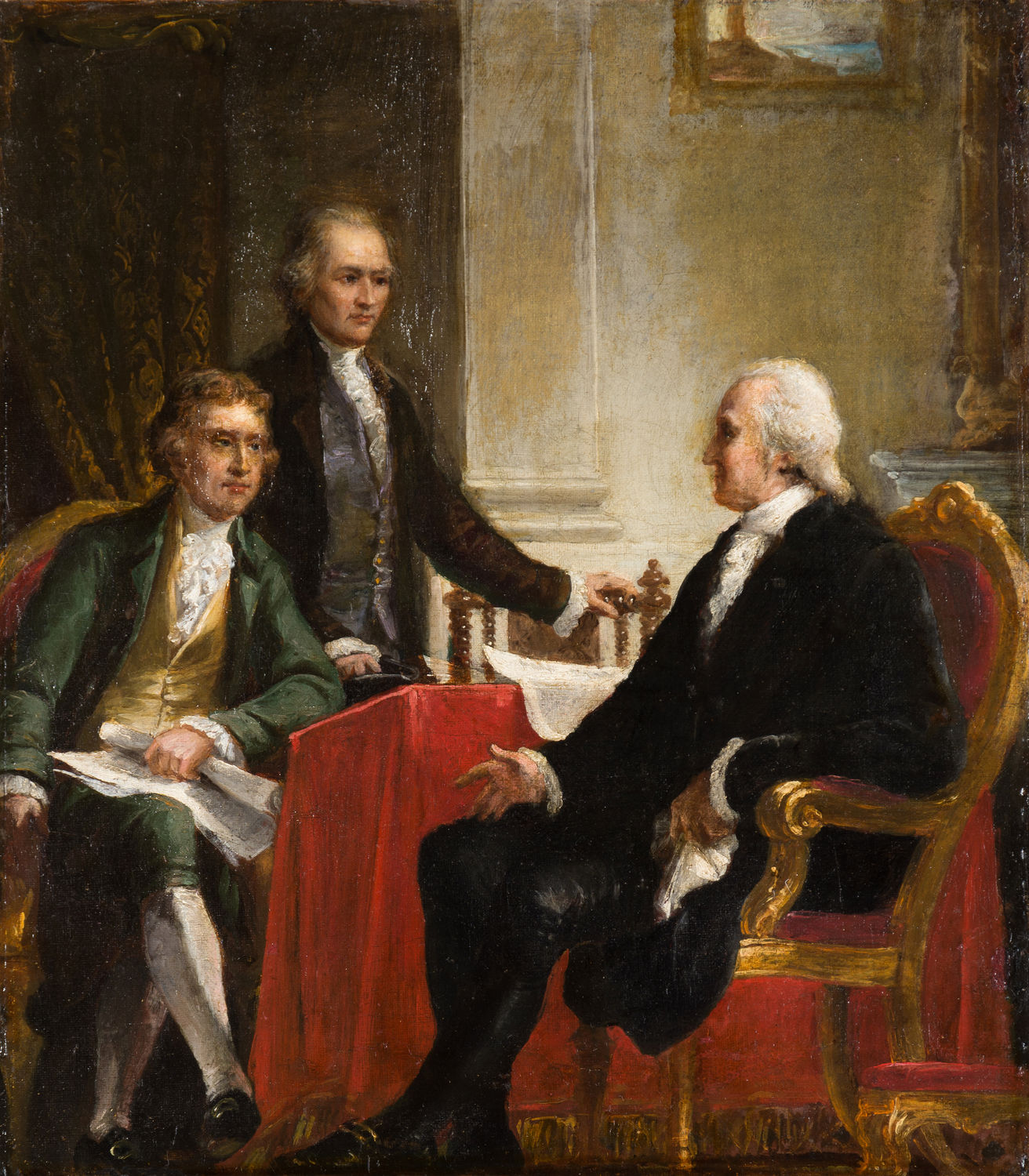
| Title | Sketch, George Washington with Jefferson and Hamilton |
| Artist/Maker | Constantino Brumidi (1805 -1880) |
| Date | 1872 ca. |
| Medium | Oil on canvas |
| Dimensions | h. 14.125 x w. 12.375 x d. 0.75 in. (h. 35.8775 x w. 31.4325 x d. 1.905 cm) |
| Credit Line | U.S. Senate Collection |
| Accession Number | 33.00028.000 |
Constantino Brumidi created this oil sketch as a preparatory study for a mural in the Senate Reception Room of the U.S. Capitol. The sketch shows President George Washington in an interior setting consulting with his two principal cabinet advisors, Thomas Jefferson and Alexander Hamilton. The level of public office achieved by each of the three founding fathers is reflected in their poses.
Brumidi portrays the nation’s first president seated in a position of authority. Washington’s gilded chair with shield medallion, proper black suit of clothes, and even his hand gestures recall Gilbert Stuart’s iconic “Lansdowne portrait,” dated 1796, in which Stuart carefully worked out the public image of Washington as leader of the young republic. The nation’s third president, Thomas Jefferson (who is shown in his role as Washington’s secretary of state), is seated across the table from Washington in a less ornate chair. Standing at the table, rather than seated with the men who served as U.S. presidents, is Treasury Secretary Alexander Hamilton. Cabinet members Jefferson and Hamilton direct their gaze toward President Washington.
The drapery behind the figure of Jefferson appears to have been a studio prop. Its distinctive pattern of crimson, gold, and green edged with bullion fringe often serves in Brumidi’s preparatory studies and finished works as a drapery, blanket, or table covering. Brumidi was faithful to the composition and many of the details he had worked out in the oil sketch when he executed the wall mural in 1874.
The privately held oil sketch, last known to go to auction in 1975, was discovered decades later in a storage unit. The Senate acquired the work in 2014. The Senate collection also holds an earlier pencil sketch by Brumidi for the Reception Room.
At age 13, Constantino Brumidi entered Rome's prestigious Accademia di San Luca and spent 14 years studying drawing, painting, and sculpture. He earned important commissions and awards during his career in Italy in the 1830s and 1840s. When Brumidi immigrated to America in 1852, his rigorous academic training and professional experience gave him a distinct advantage: Brumidi was one of the few artists in the United States who was skilled at designing murals for large, complex spaces and who was proficient at painting in fresco, a challenging but traditional medium that was desired for the murals at the U.S. Capitol.
In keeping with the practices of his academic training, Brumidi often prepared meticulous, detailed sketches to scale in pencil as one of the preliminary steps to creating a mural. Brumidi would then work up preparatory studies, typically in oil on canvas, of the proposed scenes. The preparatory studies would be submitted for review to officials in charge of the decoration of the Capitol.
Once the proposed mural in a preparatory study was approved, Brumidi would enlarge the scene from the study to a full scale rendering on oversize paper, traditionally called a cartoon. The outlines of the images could then be transferred from the cartoon onto the wall or ceiling. Brumidi used the details worked out in the studies–such as coloring or shading–as his guide when executing a mural. Many of the preparatory studies for Brumidi's work in the Senate wing of the Capitol are in the Senate collection.